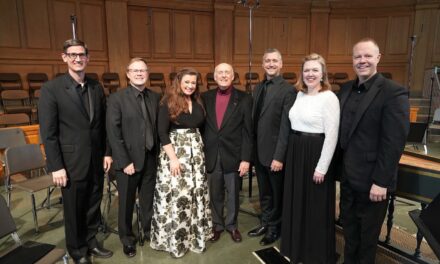Works of Art: Adrienne Albert: Poetry; Richard Faith: Highland Sketches; Lanette Lind: Dali’s Dream; Thomas Massella: The Infernal Path; Elizabeth Raum: Chagallian Scenes; & J. Mark Scearce, Rumble Strips. Wayne Leechford, baritone saxophone, Lanette Lind, piano (except in Albert and Scearce), Casey Perley, harp (in the Albert), & Scott Pollard, marimba (in the Scearce). Leechford Entertainment © 2012, TT 54:47, available on his web site $15.00 or at CDBaby.com.
All of this music was commissioned by Leechford from composers with whom he is acquainted and works or has worked in one context or another, composed in 2010, and premièred in recital at NCSU on February 7, 2011. Most pieces were inspired by a specific work in another art form, visual or literary, hence the CD’s title, not that they are not also works of art in their own right, or that Leechford’s smooth and flawless performance of them isn’t one likewise, both of which are certainly the case. Raum’s four-movement work was inspired by four different paintings by Marc Chagall, and Lind’s connects to a different surrealist painter, although it was created from listening to a chromatic scale played on the instrument and seeking to exploit its singing tone. Albert’s was inspired by Edgar Allen Poe’s poem “Annabel Lee,” the second and third movements of Faith’s were inspired by two poems of William Butler Yeats: “The Wind Blows Out of the Gates of Day” and “The Song of the Wandering Ængus.” (Its first movement seeks simply to evoke the Gælic culture using ancient modes to set a background for them.). Massella’s was inspired by some of Gustave Doré’s illustrations for Dante Alighieri’s Inferno, thus combining a visual and literary inspirational source. Only Scearce’s piece has virtually no artistic source: it is inspired by the grooved pavement that its title names, and it imitates the sound produced by tires running over it, very effectively and surprisingly pleasingly musical.
The playing order (neither of the above two) is clearly determined by the desire to alternate between the piano-accompanied pieces and those with a more novel partner instrument while at the same time creating a coherent program and experience for the listener that coincidentally builds to the single longest movement at just over 9 minutes, a length which only Albert’s 8:42-minute piece approaches, with Lind’s a minute behind it. Most of the movements range from 4 to 5 minutes in length; only one is under 2 minutes. If you think of the most common sax, the alto, as having a sort of wailing sound that is at home in a Parisian jazz basement nightclub, then the deep-throated, reedy sound of the baritone sax descends, in its lower registers, into that city’s Métro or sewer tunnels or its catacombs, down there where few bass vocalists can go. It is a very different kind of sound from the alto sax, one that is more harmonically melodic and quite pleasant, never shrill like its tenor or soprano counterparts; virtually all the music on this CD shows it off extremely well, in its various and sundry moods and styles. It is also astonishing how different it sounds depending on the accompanying instrument and how well it blends with all of them and they with it. You would probably have a difficult time imagining a harp as its partner, but it is extraordinary how lovely it sounds in that celestial context.
The colorful accompanying tri-fold insert includes an explanatory note by Leechford about the origins of the music and the recording, along with the credits, on the inside of its cover, followed by notes about each of the works by their composers on the other two inside faces, the only ones with no work of art as background. The track listings and timings appear on the outside of the tray card, with a photo of Leechford there, and, without performer photo, superimposed on a reproduction of an art work on the back of the central fold of the insert, whose other outside face contains a “Thank You” note from him. There is no detailed bio of Leechford, nor any photos of him; both photos are close-ups of different parts of the instrument, and the backgrounds of some text pages are reproductions of art works, one after a Frank Stella, the other apparently by Daniel Garrant, who handled the design. This is very appealing and attractive; it is a complementary work of graphic art in its own right, as is the face of the CD, which looks something like a colorful Impressionist painting of water swirling down a drain, perhaps to suggest the horn of the instrument. Total time is not printed anywhere; the other noticeable absence is biographical information about the composers. The CD could have accommodated yet another similarly inspired work, perhaps with yet a different partner instrument; this would have certainly pleased me yet more.
This CD is a most auspicious beginning! Regular readers will know that there’s not much music that I don’t enjoy or like, and that I also especially enjoy things that are new to my ears and different, not to say out of the ordinary. This CD certainly fits into all those categories. Very highly recommended. You should buy this; you will be both amazed and pleased. May its follow-up appear soon, and be a bit longer to more completely fill the available space!











